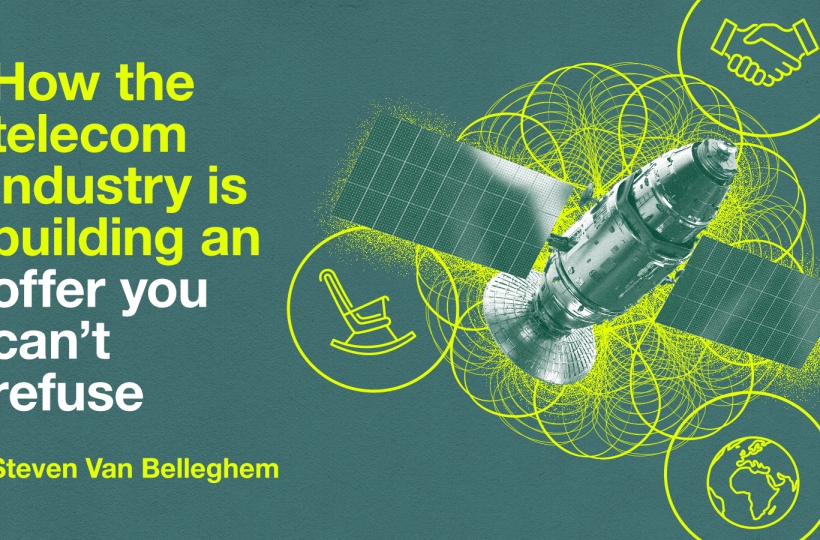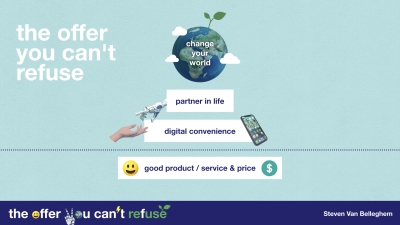How the telecom industry is building ‘an Offer You Can’t Refuse’

Offering the ultimate convenience
Vivo + Ace
Telecom service provider Vivo, Brazil’s largest mobile operator with 80 million users’ partnered with Ace Seguradora to give its customers protection while travelling via the “Vivo Seguro Viage” service. The insurance policy covers several types of expenses: from medical, hospital, dental, accident to illness, medical evacuation and baggage location, plus cancellation or interruption of the trip. The insurance is offered around the world, with the exception of countries subject to economic sanctions by the UN or the Brazilian government. It’s a great way of offering zero effort protection to its customers who want to feel safe during their travels.
AT&T’s Kiosks
AT&T, then, ventured into the healthcare industry to allow hospital patients to use the AT&T Check-in kiosk at the entrance to register themselves without the need for staff assistance and find out where they will need to go. With electronic medical records integration, patients can use the kiosks to review an appointment schedule, select an appointment time, and enter required preliminary records. The kiosks even add rideshare and transportation services to the check-in and check-out processes to further improve the patient experience. Last but not least, the kiosks can allow to streamline identity authentication as they can (optionally) be equipped with biometric authentication features, like fingerprint or facial scanning. The latter can also help staff to quickly find wandering or disoriented patients.
Deutsche Telekom’s tech incubator
Deutsche Telekom has a slightly different approach. Through its tech incubator hubraum, it brings early-stage start-ups and the leading European telco together, sparking innovation transfer and creates business opportunities for both sides. Ultimately, Deutsche Telekom’s customers too, will profit from the innovations and convenience that flow from the collaborations with the start-ups in the areas of for instance massive broadband connectivity (5G), AI, smart home, voicification, entertainment, AR/VR, tracking and IoT. I love how they are even partnering with start-ups that have the potential power to disrupt the telco industry with tech innovations like blockchain, neuroscience and human machine interfaces.
An example of a Deutsche Telekom hubraum partnership is the ultraconvenient eParkomat: a platform that predicts parking spaces availability on and off-street in real time by using AI and real-time Big Data to analyze the mobile operators’ cellular networks. Another one is the book-summarizing subscription service Blinkist which has about seven million users and provides 15-minute read summaries of more than 2,500 bestselling non-fiction books.
Partner in Life
NTT + Toyota: a better citizen life
One of my favourite examples in the matter has to be Woven city, which is a smart city collaboration between car builder Toyota and the Japanese telecom player NTT. Toyota decided to become a mobility partner in the lives of its customers and intends to build an experimental city, as of 2021. To implement this project, Toyota is collaborating with the Japanese telecom player NTT, who will in its turn become the Partner in Connectivity for the residents of the city, connecting people, vehicles and buildings via smart censors. The purpose of this remarkable initiative is to see how the full potential of a city can be most efficiently utilised, whilst at the same time offering high standard of living to its inhabitants.
Orange + Dacom: a better life for farmers
Orange has a Smart Agriculture vertical within its Smart Cities & Territories strategic program to become a Partner in the (Business) Life of farmers. As digital services are becoming more accessible and farmers are more aware of the opportunities that new technologies provide, it started to offer solutions to connect sensors for fields, machines and livestock monitoring, agricultural machinery tracking and traceability and shipping control.
One example is its partnership with Dacom to help farmers enable digital services and support them in their day-to-day decision making. Another is how Orange Labs researchers have developed a measuring and visualization tool – Pig Data (as an analogy with Big Data, of course) – able to make use of data from pig farms in order to allow precision agriculture with Li-Fi, a wireless communication technology that uses light.
Telenor as a Life Partner for its employees
In my book, The Offer You Can’t Refuse, I also talk about the OYCR for employees, which plays a crucial part in creating an OYCR for your customers. Telenor, one of the largest telecom players in the world, is a great example of the Life Partner OYCR strategy for employees. One of the greatest difficulties facing the company is recruiting and keeping the right talent to tackle the challenges that the telecom industry will face in the years ahead. More than ever, the sector needs people with a technological profile: strong in AI, data analysis and programming.
As many others, Telenor has been struggling to find these people. And so, it decided to launch a large-scale retraining programme for its own people, working together with the online training institutes Udacity and Coursera. Employees with an administrative background were encouraged to follow courses in for instance data science. This kind of talent is often hard to find on the external labour market, so by retraining its own internal candidates Telenor was able to generate a double benefit: the talent was immediately available and the employees concerned were enthusiastic about their change of career direction. As keeping their profile interesting for the labour market is a lifelong worry of employees, Telenor is able to become a Partner in the Learning Life of its employees.
Saving the world
Starlink: Internet for everyone
One of the best ways for telecom (related) companies to save the world is to fight the inequality that comes with lack of internet access. The best known project here is probably SpaceX’ Starlink project which is meant to deliver high speed broadband internet – through satellites – to locations where access has been unreliable, expensive, or completely unavailable. It is targeting service in the Northern U.S. and Canada in 2020, rapidly expanding to near global coverage of the populated world by 2021.
AT&T + Loon: better coverage in disaster areas
Alphabet’s Loon is another disruptive outlier focused on providing connectivity. They have a different approach than Starlink, though, working with high-altitude, stratosphere skimming balloons that can act as on-demand, deployable cell towers. At the beginning of 2020, the more traditional telecom player AT&T signed an agreement with Loon to help people with better coverage in disaster areas. This partnership is meant to help Loon ensure it’s in a much better position to address any potential need for disaster response cellular network coverage, thanks to integration with AT&T and its global network partners.
Belgian Telecom operators against COVID-10
In my home country Belgium the main telecom operators supported the public authorities’ Track & Trace call center in its fight against the spread of the Covid19 virus. As the volume of outgoing calls and SMS from this center was expected to be particularly high, BASE, Orange Belgium, Proximus, Scarlet, Telenet and VOO unanimously decided not to charge any interconnection and termination fee for these calls and SMS. The latter obviously translated in a massive reduction of the operational costs of the call center operated by the government.
Telenet offering low budget internet to lower income families
Telenet, one of Belgium’s Telco providers, started offering a basic internet product for families with a lower income. For only 5 Euro per month everyone can have access to a fast internet connection. As connectivity is more important than ever, they are helping families to give them access to information but also access to eduction for their children. Telenet is using their assets to help society with this offering.
Ericsson and Telia + Einride & DB Schenker: sustainable transport
Telecommunications companies Ericsson and Telia teamed up with Swedish transport company Einride and supply chain management and logistics solutions company DB Schenker to co-create a safer, more sustainable transport ecosystem using 5G. They see 5G as a key enabler of sustainable transport as it provides the connectivity and reliability needed to safely introduce all-electric, autonomous trucks onto public roads.
The Ericsson Radio System and Cloud Core for 5G provide high-performance connectivity to Einride’s T-pod – a driverless vehicle operating continuously at DB Schenker’s logistics facilities in Jönköping, Sweden. The T-pod and autonomous transport system could potentially replace more than 60 percent of today’s transport with a sustainable, affordable alternative.
